About Kingmax Hercules DDR3 2200 overclocking memory and overclocker variants
About what acceleration is and why it is needed, it’s not worth telling to habraly people. Those who are fond of this occupation are called for some reason not overclockers or overclockers, but overclockers. However, the guys are not offended. But the trouble is: there are two types of overclockers, one of which is found mainly in the fantasies of marketers, and the other lives in real life. According to marketers, an overclocker is a person obsessed with speed for speed, and ready to pay at least a dollar for each additional megahertz. Such people buy with kilograms everything that huge radiators, water cooling systems and thick copper tubes stand on, and in general they are so severe that instead of ice they add liquid nitrogen to whiskey.
The same overclockers that I myself had to watch are usually interested in buying budget solutions and bringing them to the state of top-notch with minimal effort. They are more interested in not thick-thick tubes, but things more prosaic: unlocking additional cores in processors, increasing the frequency of the chip and memory of the video card, including stream processors in the GPU (although this fun has been practically inaccessible lately). That is, the task is not to spend more and spread your fingers in front of your like, but, on the contrary, to save. Who is right, marketers or me, decide for yourself. And in this post I want to talk a little about memory, which, on the one hand, fully corresponds to the fantasies of marketers, and on the other hand, is relatively acceptable.
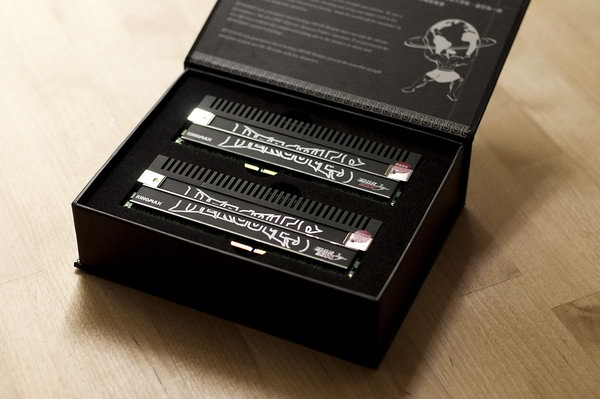
This is a set of Kingmax Hercules DDR3 2200. Two of the straps included in it are capable of operating at a real frequency of up to 1100 MHz, which gives an effective frequency equal to an impressive 2200 MHz. Lot? Yes, not the right word. I still can’t forget what impression the Pentium III-600 processor made, and already the memory storms the frequencies, which are much more severe. It just doesn’t fit in my head, as Sasha Gray once said after filming a scene with Rocco Siffredi.
Kingmax Hercules comes in a large shiny box (as you know, overclockers from the marketer's dreams just go crazy about the boxes, and the bigger they are, the better). On the inner cover you can read a short version of the legend of Hercules (Hercules - this is Hercules) in two languages, and it emphasizes that this glorious warrior was distinguished by transcendent decency and achieved everything without cheating. Between us, this is not entirely true, because Hercules soaked women for the sake of a belt, and stole cows with apples. Well, let's hope that among potential buyers of a set of bores, like me, a little.

Radiators in memory - my respect. Not only that tall, almost double the height of the module, but also cooling fins on top are arranged in three rows. Considering that the heatsink is pressed very tightly onto the chips, plus they did not save on the heat-conducting gasket, there should be no problems with the heat sink. Just do not be surprised that in the photo the cloves go apart: the radiator is not solid.

The chips under the radiator are neatly labeled like KINGMAX KFB8FFJXF-DXX-09Z. Of course, I would be glad to believe that Kingmax learned how to make chips by itself, but, as we all know, this is not so. Digging on the Internet has shown that it is actually Elpida BBSE. However, by and large, it doesn’t matter if only it works.
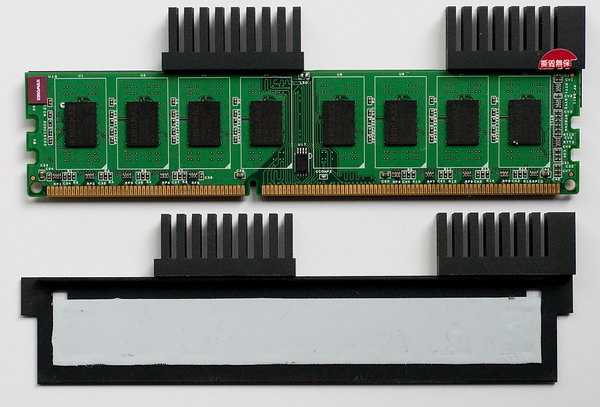
Fortunately, it just works. An important advantage of this kit is that it starts up safely without manually raising the voltage in the BIOS.
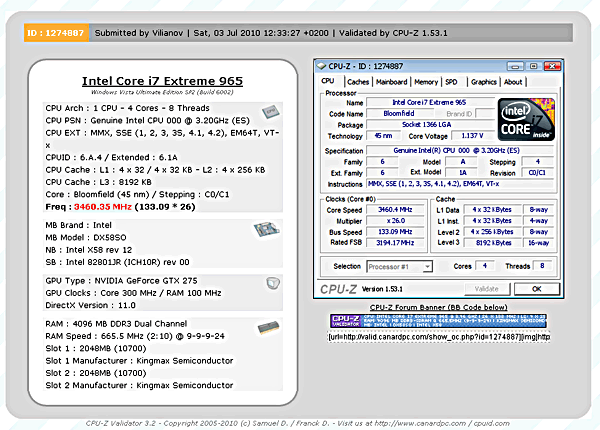
It seems like a trifle, but you would know how many Corsair and OCZ modules are being handed over to stores with the motivation “marriage, does not work” simply because the buyer was too lazy to carefully read the attached pieces of paper. On the other hand, who said that he should do this at all? Overclocker - yes, it cuts in timings, and in voltage, and CAS differs from RAS. And those who are flattered by a beautiful box and huge radiators are also, in general, people. And Kingmax treats them (and sellers) very humanely.
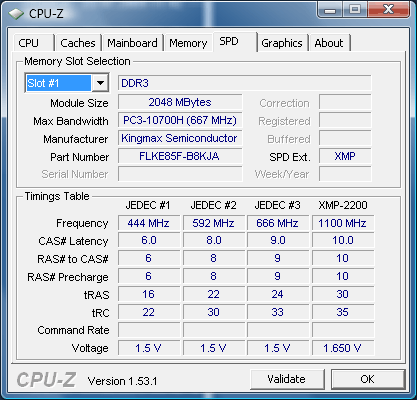
So, for work. At my motherboard's 1333 MHz memory frequency, Kingmax Hercules works simply amazingly with timings of 6-7-6-18-88-1T. This, as we understand it, is much better than those prescribed in SPD 9-9-9-24-24-74-1T, so even those who bought this memory for beauty will not be able to get into the BIOS once. It was easily overclocked to 1600 MHz, only having thrown off the timings for passport for 1333, but then it became sad ... No, it's not in the memory, it’s just good.
It was just a year and a half old that just hit my Intel DX58SO motherboard, and when it came out, the maximum memory frequency on it was limited to 1066 MHz. Yes, like that. Then came the new BIOS, which "allowed" the more acceptable 133 MHz, but this seems to be almost the limit. The relatively low frequency is compensated by the support of the three-channel operation mode, and therefore I am not in a hurry to upgrade. At the same time, I’m going to build a test bench for P55 or H55 for a long time, so that from now on I will avoid such embarrassments with megabytes ...
On the Internet I found several reviews of Kingmax Hercules (this onenot bad), and in all the memory of the promised frequency still reached. True, I didn’t especially drive further, but, on the other hand, is there any sense in further acceleration? After all, whatever one may say, but from time immemorial to this day the only important characteristic of RAM is its volume. And overclocking for overclocking ... Well, I don’t know. Not mine.
And about the very important - about prices. When the Kingmax Hercules set went on sale (it was in March), it cost, scary to say, $ 330-350. Now the price has dropped to a very reasonable $ 220-230. Also, of course, not cheap. But the same, for example, is a 4-gigabyte Corsair Dominator GT kit with a maximum declared frequency of 1600 MHz.
Of course, there are still plenty of offers of 4-gigabyte fast memory sets with beautiful heatsinks in the region of $ 130-160, but we must understand that in this case we are talking about a surcharge for a radiator, while the chips inside are the most common. Therefore, if you are a moderate overclocker or just a normal person :), it makes sense to buy the most simple memory with a passport frequency of 1333 MHz and try to slightly overdrive it. In this case, you should not worry about radiators, because at a voltage of 1.45-1.5 V, the heating of the chips is minimal. “Just memory” DDR3 in pedigree modules of 2 gigabytes is now sold at approximately $ 60-65 per item (ie $ 120-130 per pair).
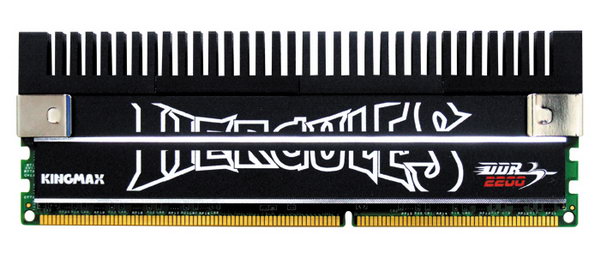
But the funny thing is that taking out Kingmax Hercules and replacing them with your own, also very worthy of Aeneon X-Tune, is just a passion, as I did not want. Painters are really beautiful :)
The same overclockers that I myself had to watch are usually interested in buying budget solutions and bringing them to the state of top-notch with minimal effort. They are more interested in not thick-thick tubes, but things more prosaic: unlocking additional cores in processors, increasing the frequency of the chip and memory of the video card, including stream processors in the GPU (although this fun has been practically inaccessible lately). That is, the task is not to spend more and spread your fingers in front of your like, but, on the contrary, to save. Who is right, marketers or me, decide for yourself. And in this post I want to talk a little about memory, which, on the one hand, fully corresponds to the fantasies of marketers, and on the other hand, is relatively acceptable.

This is a set of Kingmax Hercules DDR3 2200. Two of the straps included in it are capable of operating at a real frequency of up to 1100 MHz, which gives an effective frequency equal to an impressive 2200 MHz. Lot? Yes, not the right word. I still can’t forget what impression the Pentium III-600 processor made, and already the memory storms the frequencies, which are much more severe. It just doesn’t fit in my head, as Sasha Gray once said after filming a scene with Rocco Siffredi.
Kingmax Hercules comes in a large shiny box (as you know, overclockers from the marketer's dreams just go crazy about the boxes, and the bigger they are, the better). On the inner cover you can read a short version of the legend of Hercules (Hercules - this is Hercules) in two languages, and it emphasizes that this glorious warrior was distinguished by transcendent decency and achieved everything without cheating. Between us, this is not entirely true, because Hercules soaked women for the sake of a belt, and stole cows with apples. Well, let's hope that among potential buyers of a set of bores, like me, a little.

Radiators in memory - my respect. Not only that tall, almost double the height of the module, but also cooling fins on top are arranged in three rows. Considering that the heatsink is pressed very tightly onto the chips, plus they did not save on the heat-conducting gasket, there should be no problems with the heat sink. Just do not be surprised that in the photo the cloves go apart: the radiator is not solid.

The chips under the radiator are neatly labeled like KINGMAX KFB8FFJXF-DXX-09Z. Of course, I would be glad to believe that Kingmax learned how to make chips by itself, but, as we all know, this is not so. Digging on the Internet has shown that it is actually Elpida BBSE. However, by and large, it doesn’t matter if only it works.

Fortunately, it just works. An important advantage of this kit is that it starts up safely without manually raising the voltage in the BIOS.

It seems like a trifle, but you would know how many Corsair and OCZ modules are being handed over to stores with the motivation “marriage, does not work” simply because the buyer was too lazy to carefully read the attached pieces of paper. On the other hand, who said that he should do this at all? Overclocker - yes, it cuts in timings, and in voltage, and CAS differs from RAS. And those who are flattered by a beautiful box and huge radiators are also, in general, people. And Kingmax treats them (and sellers) very humanely.

So, for work. At my motherboard's 1333 MHz memory frequency, Kingmax Hercules works simply amazingly with timings of 6-7-6-18-88-1T. This, as we understand it, is much better than those prescribed in SPD 9-9-9-24-24-74-1T, so even those who bought this memory for beauty will not be able to get into the BIOS once. It was easily overclocked to 1600 MHz, only having thrown off the timings for passport for 1333, but then it became sad ... No, it's not in the memory, it’s just good.
It was just a year and a half old that just hit my Intel DX58SO motherboard, and when it came out, the maximum memory frequency on it was limited to 1066 MHz. Yes, like that. Then came the new BIOS, which "allowed" the more acceptable 133 MHz, but this seems to be almost the limit. The relatively low frequency is compensated by the support of the three-channel operation mode, and therefore I am not in a hurry to upgrade. At the same time, I’m going to build a test bench for P55 or H55 for a long time, so that from now on I will avoid such embarrassments with megabytes ...
On the Internet I found several reviews of Kingmax Hercules (this onenot bad), and in all the memory of the promised frequency still reached. True, I didn’t especially drive further, but, on the other hand, is there any sense in further acceleration? After all, whatever one may say, but from time immemorial to this day the only important characteristic of RAM is its volume. And overclocking for overclocking ... Well, I don’t know. Not mine.
And about the very important - about prices. When the Kingmax Hercules set went on sale (it was in March), it cost, scary to say, $ 330-350. Now the price has dropped to a very reasonable $ 220-230. Also, of course, not cheap. But the same, for example, is a 4-gigabyte Corsair Dominator GT kit with a maximum declared frequency of 1600 MHz.
Of course, there are still plenty of offers of 4-gigabyte fast memory sets with beautiful heatsinks in the region of $ 130-160, but we must understand that in this case we are talking about a surcharge for a radiator, while the chips inside are the most common. Therefore, if you are a moderate overclocker or just a normal person :), it makes sense to buy the most simple memory with a passport frequency of 1333 MHz and try to slightly overdrive it. In this case, you should not worry about radiators, because at a voltage of 1.45-1.5 V, the heating of the chips is minimal. “Just memory” DDR3 in pedigree modules of 2 gigabytes is now sold at approximately $ 60-65 per item (ie $ 120-130 per pair).

But the funny thing is that taking out Kingmax Hercules and replacing them with your own, also very worthy of Aeneon X-Tune, is just a passion, as I did not want. Painters are really beautiful :)
